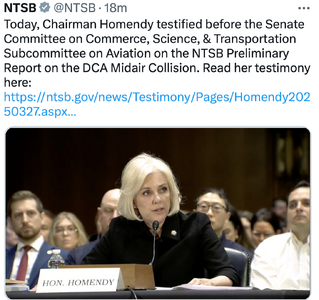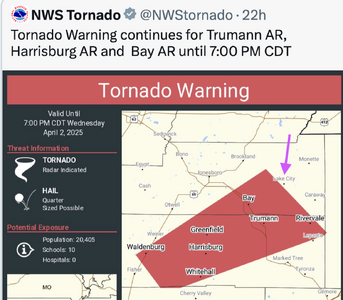I'm a bit perplexed at your statement above, however, that the NWS should never have been allowed to provide forecasts and/or manpower to "private interests," unless there's something I'm missing here. Had that been the case back in 1981, The Weather Channel may have never gotten off the ground!
Dick Halgren, then director of the NWS, did all kinds of things for The Weather Channel he never would have done for anything else which was
against official federal policy at the time. For example, the coding of zone forecasts and warnings was specifically for TWC's "Weather Star" which was the device that allowed each cable system to have their local forecast, warnings, etc. The original coding was unique to the Star device and not compatible with any other devices. Why should TWC have
exclusive service from the NWS and not AccuWeather, WeatherScan or any other private weather company in business at the time? That was pure corporate welfare.
I don't mean to get too far off topic here, but have to strongly disagree with you on this. NOAA satellites are/were produced by the private sector, and we got a pretty great result for the money spent. I don't see much bloat in their designs. There was some serious bloat in the selection process and mission criteria (which is where government tends to always struggle, but they are trying to balance the needs of many groups, not just investors).
Hi Dave, thanks for your comment. I appreciate the chance to clarify.
Yes! NESDIS/NOAA/NASA satellites are marvels. They are school bus-sized platforms that
do enable the saving of lives (indirectly through weather forecasts and
directly through their ability to sense and relay distress signals in the far corners of the earth).
But you also wrote, "There was some
serious bloat in the selection process and
mission criteria" -- which is exactly my criticism. The original GOES satellites were designed in an era where NASA had an (expensive) monopoly on launches. So, to save $$, the theory was "let's cram every instrument onto a single satellite" and launch once. Of course, that is putting the meteorological eggs in one basket and that has been disastrous as we've lost a couple of them. We were in desperate shape in the late 80's when one failed and the replacement blew up shortly after launch.
This is a perfect example of NWS/NESDIS/NOAA/NASA being very late to adapt to new technology.
Launches are now so cheap they are almost a commodity -- 30 to 40 times less per pound lifted (including the inflation adjustment) -- than in the early stages of GOES and POES. A number of experts (I'm not an expert) say it would be less expensive, less risky, and result in better quality results to add the latest technology onto 2-3 smaller satellites rather than launching "school buses." For example, put the meteorological instruments on one satellite, the search & rescue and related items on a second, and turn the GOES "relay" function over to ordinary commercial weather satellites. As far as I can tell, NOAA is planning on launching school buses for the foreseeable future.
I never said the NWS had a monopoly on warnings or that they do not sometimes get things wrong. However, many people and organizations DO rely on the NWS for warnings and if you degrade the quality of the NWS you degrade the quality of the warnings. And if you reduce the quality of warnings and/or the number of ways people can get warnings, you put people in danger. Yes, most people have smartphones (though there are subgroups where that is less true), but the EAS alerts for tornado warnings and others do originate from the NWS.
John, again:
I want a strong, vibrant NWS that executes its core mission (forecasts, warnings, data for the public-at-large) with excellence!!!!!
I want the NWS to stop all non-core activity NOW. Did you know the NWS no longer has a school for radar and storm warning training (it used to be in OUN and was closed in 2004)? But, instead of training people to issue quality warnings, they have started a
240 hour school to teach meteorologists how to perform IDSS duties! Their priorities are exactly backward. I'll say it again: If the St. Louis Cardinals, for example, want special, site-specific forecasts and warnings, they can hire a commercial weather company to provide them.
If I didn't want NWS and EM excellence, there would be no need for the DRB.
In the era of "Obamaphones," I worry much less that people who aren't as well off as you or I don't have access to smartphones and the storm warnings they can provide. We don't live in a perfect world and never will.
Everyone should have storm
quality storm warnings available to them. Right now, the NWS too often doesn't provide the quality it did 15 years ago. Surely, the regression in warning quality is not acceptable to you!?
To everyone:
I am well aware there are some within NOAA,
even pre-DOGE, that want to close some/many of the ~124 NWS offices in favor of:
- Returning to the old WSFO/WFO model (pre-NEXRAD) where a single office in the state does the forecasting and the other radar offices do the warnings. In some cases where offices are geographically close (TOP and KC [EAX]), offices would be closed.
- A "climate region" (e.g., Rocky Mountains, Southern Great Plains) regional office model that would do all of the forecasting and warnings. Each radar location would have a small contingent of techs and perhaps a met or two to gather local storm reports, etc.
- Or -- believe it or not -- set up a storm warning model similar to SPC and the National Water Center for warnings! For example, all SVR, TOR and FFW's would be issued by a single office!
I assure you, my sources regarding the above are excellent, The decision has already been made to merge WPC and CPC into one organization. I have been aware these discussions began with Joe Biden as President. Nothing may happen or a lot may happen. And, I continue to fear malicious compliance.
My personal opinion is that the present model will work just fine if the NWS cuts out the distractions (IDSS, etc.) and teaches their dedicated work staff to issue excellent products as they did when their training operation (OUN school 1991-2004) was in operation. They also need to go "back to the future" with instructors with the abilities of, say, a Joe Bastardi, etc., on non-model forecasting techniques for 0-48 hour forecasts. In a situation of returning Gulf moisture with ACCAS exploding in the sky means nocturnal thunderstorms in the region will occur regardless of what the HRRR might say.
We have a chance to influence all of this: Go to your congresspeoples' web sites and tell them your concerns and what you think the future should look like. I will caution that telling them to "leave everything alone" or "lives are at stake, don't cut anything" is a losing proposition. But, constructive changes will likely be well received.
Enjoy your weekend and the opportunities to (safely!) chase.
9pm CDT Friday: When I wrote the above about Joe Bastardi and non-model forecasting, I was completely unaware of this:
The Predicted Severe Storms Never Occurred. Why?
I cannot overemphasize how many of their forecasts bust because of ignorance of forecasting techniques we were taught in our first applied forecasting class in 1972.



